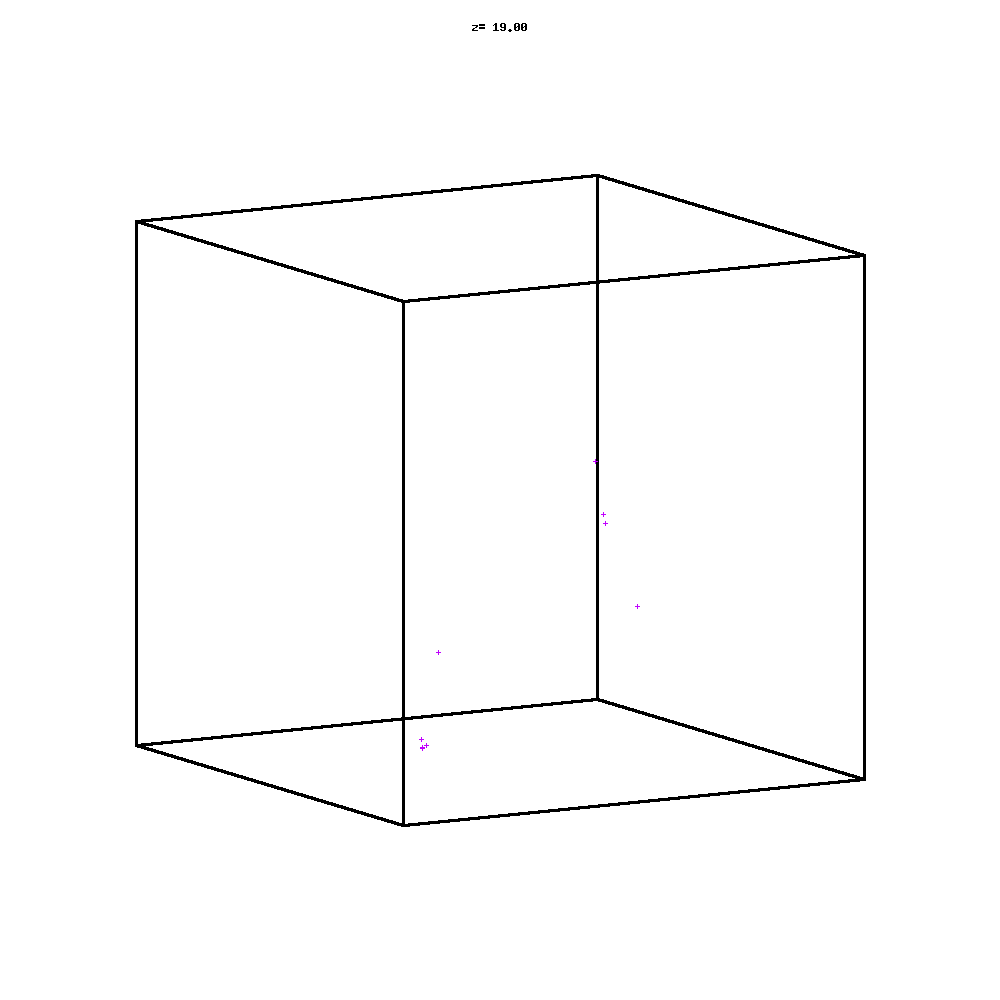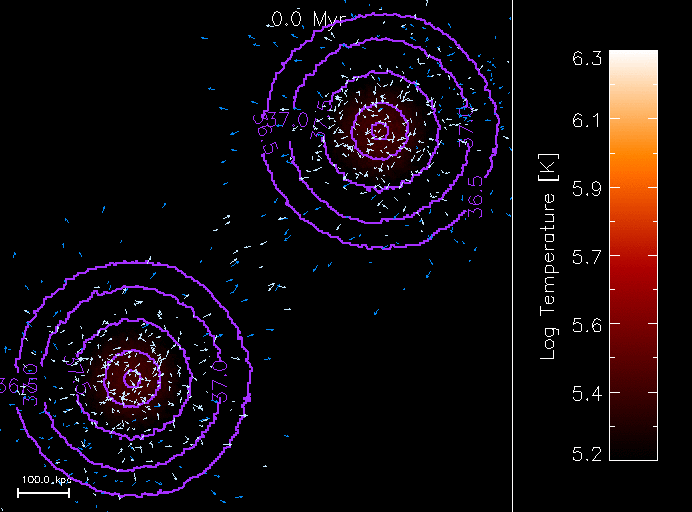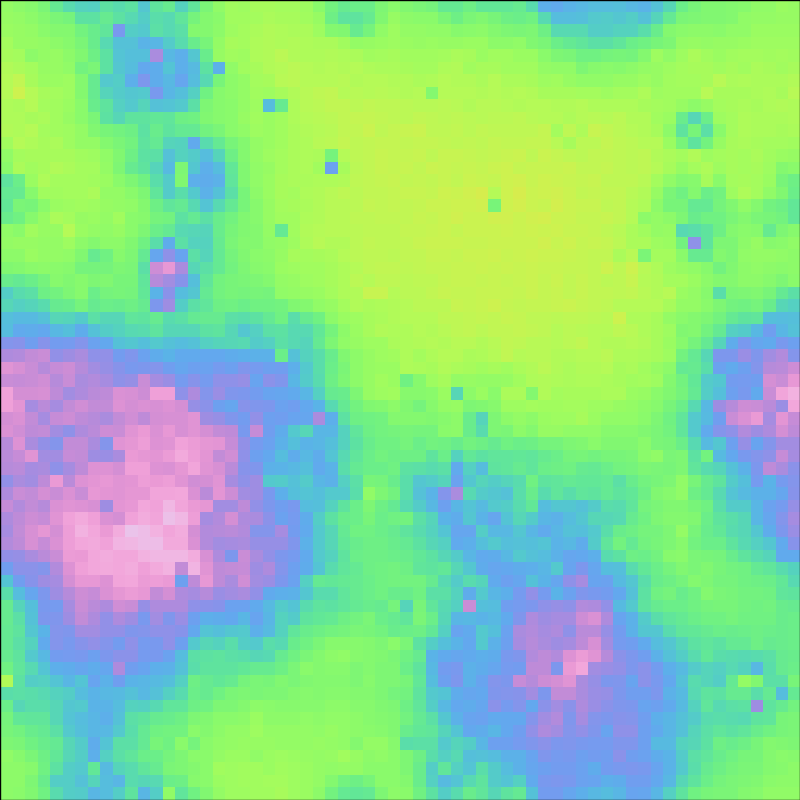Radiative feedback from the first black holes. Differences between 2LPT and ZA (with Kelly Holley-Bockelmann and J. Wise)
Punch-line: 2LPT halos (and the corresponding POPIII stars) form earlier, the POPIII remnant -- a blackhole has more time
to grow in the 2LPT simulations and grows to be more massive in the 2LPT simulations. Correspondingly, the 2LPT black holes produce
more copious ionizing radiation and help in kick-starting reionization. Here we compare the image of
electron fraction at various redshifts. Corrsponding paper
arXiv:1211.1394 (accepted to ApJL)
Electron fraction at z=6. Play around with the slider, you know you want to :)
Dark matter halo flybys in cosmological simulations (with Kelly)
Galaxy mergers are very important since they drive the morphological/kinematic transformations
of galaxies. However, while analyzing cosmological simulations, I found another class
of interactions - halo flybys - where two halos inter-penetrate but then separate at
a later time and (mostly) never merge. We presented the first census of the frequency of flybys
in a cosmological simulations in Paper 1 -- now accepted by ApJ.
Here is a full resolution pdf copy
PDF for astro-ph/1103.1675 (878 KB).
The bottom line is that flybys (think of flybys as minor mergers in terms of perturbation)
are frequent and more numerous than mergers for z less than 2. So, we are now running very high-resolution
idealized simulations to figure out the impact of flybys on galactic structure.
Semi-analytical black hole growth using cosmological simulations (with Kelly and M. Micic)
I am currently studying black hole growth in Milky-Way sized galaxies using dark-matter only
cosmological simulations. Here is a gif animation of the entire simulation, the circles show the halos
and the 'plus' symbols show the locations of the black hole particles. There are about 1400 black holes
in the box.

Hot Halo Gas in Galaxy Mergers (Thesis)
I work on high-resolution numerical simulations of colliding
galaxies with a baryonic halo. For this, I have first initialized a dark matter
NFW halo with an equilibrium gas fraction. The dark matter
position and velocities are obtained from a numerically calculated
distribution function for the joint dark matter and gas
distribution.
I studied the mergers of galaxies for a range of
mass-ratios, gas fractions and impact parameters (for a parabolic orbit); a total
of 36 simulations. Select results are directly shown in the following images.
The following figure shows a strong shock being formed
during the merger (Left panel) and the evolution of unbound + hot and unbound
gas fraction in the right panel. The figure is from an equal-mass merger with an impact
parameter of ~20 kpc.
Gif Animation
This is from a parabolic equal-mass merger with an impact parameter of ~110 kpc. The
contours show the projected X-ray luminosity while the arrows show the velocities
of a random fraction of the unbound particles (identified at the end of the simulation).

The following figure shows the shocks in the simulation.
The strongest shocks are created when the material flung out as the nuclei make a close pass interacts
with pre-heated material from the initial shock.
Gif animation
Corresponding paper (local copy)
(pdf, 1.8MB)
Can the IGM be fueled by mergers ? (Thesis)
I found that every merger resulted in some fraction of the halo gas getting unbound. Now,
mergers are quite frequent and play a critical role in the formation of structure in
the Universe. As such, if every mergers release some fraction of the gas, then the
cumulative amount could be significant. To estimate this, I use an semi-analytic
Extended Press-Schechter merger tree (using the public GALFORM code from the Durham
group,
paper) and track the gas fractions
of each halo accurately. All halos that appear for the first time are given the universal
gas fraction (all halos at the highest z, 10 is what I used qualify). Afterwards, I
track the unbound gas fractions consistently through the entire merger tree. Convolving
with the evolving number density of the halos, I get the fractional mass in the Universe
contributed by mergers of galaxies. Here is the related
paper on ADS.

The Major1 line represents the mass-fraction of the unbound gas when all mergers bigger than
3:1 release 10% of the gas in the incident halos. The Minor1 is the same but when considering
all mergers bigger than 10:1 release 10% of the gas. Since there are many more 10:1 mergers
in the Universe than 3:1, the 10:1 line is always greater than the 3:1. The shaded region
shows the 1-sigma deviation from the mean. Thus, up to 35% of the gas can be released just
by mergers.
Now, my original simulations do not include any AGN feedback or starburst-driven galactic-scale winds.
Those will work in addition to the unbinding caused by the merger.
Generating equilibrium galaxy models (Thesis)
Some day I will fill this in. But in the meantime, check out the HALOGEN code
from Marcel Zemp
here.
Or you can get the
GALACTICS (now in NEMO) program.
A good place to start learning about the initialisation technique would be
The
Art of Computational Science (Initialising a Plummer model).






